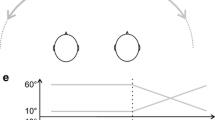Abstract
The precedence effect refers to a group of auditory phenomena related to the ability to locate sound sources in reverberant environments. In the present study, this phenomenon was investigated using two moving signals. The first signal was direct (lead) and the other was delayed (lag). The motion of the sound source was created by successive switching of ten loudspeakers. The continuity of the motion was created by simultaneously attenuating the stimulus in the previous loudspeaker and enhancing it in the next one. The length of the path of the lead and lag was 34°. The lead moved from 34° to 0° (to the right) and the lag moved –52° to –86° (to the left). The duration of the lead and the lag was 1 s. Lead–lag delays ranged from 1 to 40 ms. Subjects had to indicate the location of the lag. The results indicate that the lead signal dominated in the sound localization at short delay durations (up to 18 ms). In spite of the instructions, all the subjects pointed at the lead, which suggests that they perceived the lag in this location. Two distinct sounds were perceived at the longest delays. The mean echo threshold and its standard deviation in eight subjects was 9.6 ± 4.5 ms.
Similar content being viewed by others
References
Wallach, H., Newman, E.B., and Rosenzweig, M.R., The precedence effect in sound localization, Am. J. Psychol., 1949, vol. 62, no. 3, p. 315.
Blauert, I., Prostranstvennyi slukh (Spatial Hearing), Moscow, 1979.
Litovsky, R.Y., Colburn, H.S., Yost, W.A., and Guzman, S.J., The precedence effect, J. Acoust. Soc. Am., 1999, vol. 106, p. 1633.
Guzman, S.J. and Yost, W.A., Breakdown of echo suppression with multiple echoes, J. Acoust. Soc. Am., 1995, vol. 98, p. 2907.
Yost, W.A. and Guzman, S.J., Auditory processing of sound sources: Is there an echo in here?, Curr. Dir. Psychol. Sci., 1996, vol. 5, no. 4, p. 125.
Agaeva, M.Yu., The precedence effect and a moving signal, Sens. Sist., 2010, vol. 24, no. 4, p. 227.
Agaeva, M.Yu., The precedence effect in the horizontal and vertical planes in experiments with a moving lagging signal, Hum. Physiol., 2011, vol. 37, no. 5, p. 545.
Al’tman, Ya.A., Prostranstvennyi slukh (Spatial Hearing), St. Petersburg: Inst. Fiziol. im. I. P. Pavlova Ross. Akad. Nauk, 2011.
Al’tman, Ya.A., Lokalizatsiya dvizhushchegosya istochnika zvuka (Moving Sound Location), Leningrad: Nauka, 1983.
Perrott, D.R. and Musicant, A.D., Minimum auditory movement angle: Binaural localization of moving sound sources, J. Acoust. Soc. Am., 1977, vol. 62, no. 6, p. 1463.
Bardin, K.V., Problema porogov chuvstvitel’nosti i psikhofizicheskie metody (The Problem of Sensitivity Thresholds and Psychophysical Methods), Moscow: Nauka, 1976.
Litovsky, R.Y. and Shinn-Cunningham, B.G., Investigation of the relationship among three common measures of precedence: Fusion, localization dominance, and discrimination suppression, J. Acoust. Soc. Am., 2001, vol. 109, no. 1, p. 346.
Agaeva, M., Velocity discrimination of auditory image moving in vertical plane, Hear. Res., 2004, vol. 198, nos. 1—2, p. 1.
Carlile, S. and Best, V., Discrimination of sound source velocity in human listeners, J. Acoust. Soc. Am., 2002, vol. 111, no. 2, p. 1026.
Grantham, D.W., Detection and discrimination of simulated motion of auditory targets in the horizontal plane, J. Acoust. Soc. Am., 1986, vol. 79, no. 6, p. 1939.
Yang, X. and Grantham, D.W., Echo suppression and discrimination suppression aspects of the precedence effect, Percept. Psychophys., 1997, vol. 59, no. 7, p. 1108.
Yang, X. and Grantham, D.W., Localization suppression and echo suppression aspects of the precedence effect, J. Acoust. Soc. Am., 1995, vol. 97, no. 5, p. 3280.
Blauert, J., Spatial Hearing: The Psychophysics of Human Sound Localization, Cambridge, Mass.: MIT, 1997.
Freyman, R.L., Cliffton, R.F., and Litovsky, R.Y., Dynamic processes in the precedence effect, J. Acoust. Soc. Am., 1991, vol. 90, no. 2, p. 874.
Agaeva, M.Yu. and Al’tman, Ya.A., Differential velocity thresholds for an auditory target moving in the vertical plane, Acoust. Phys., 2004, vol. 50, no. 3, p. 278.
Cliffton, R.F., Freyman, R.L., and Litovsky, R.Y., and McCall, D.D., Listeners’ expectation about echoes can raise or lower echo threshold, J. Acoust. Soc. Am., 1994, vol. 95, no. 3, p. 1525.
Author information
Authors and Affiliations
Corresponding author
Additional information
Original Russian Text © M.Yu. Agaeva, 2017, published in Fiziologiya Cheloveka, 2017, Vol. 43, No. 4, pp. 5–12.
Rights and permissions
About this article
Cite this article
Agaeva, M.Y. The precedence effect for signals moving in the horizontal plane. Hum Physiol 43, 359–365 (2017). https://doi.org/10.1134/S0362119717030021
Received:
Published:
Issue Date:
DOI: https://doi.org/10.1134/S0362119717030021




